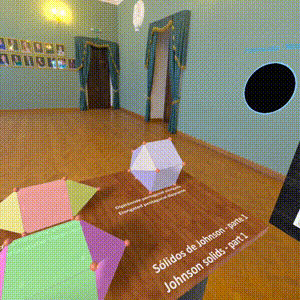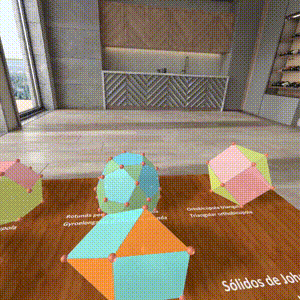Visualization of polyhedra with Augmented Reality (AR) and Virtual Reality (VR) in A-frame
author: Paulo Henrique Siqueira - Universidade Federal do Paraná
contact: paulohscwb@gmail.com
versão em português
 Johnson solids - part 1: J1 - J32
Johnson solids - part 1: J1 - J32
A Johnson solid is a strictly convex regular-faced polyhedron that is not uniform. They are named after Norman Woodason Johnson, who in 1966 first listed all 92 such polyhedra. In this first part, we have first 32 Johnson solids.
Augmented Reality | 3D Models | Home
Immersive rooms
🔗 room 1 | 🔗 room 2 | 🔗 room 3



Augmented Reality
To view Johnson solids in AR, simply visit:
https://paulohscwb.github.io/polyhedra/johnson1/ra.html
with any browser with a webcam device (smartphone, tablet or notebook).
Access to the VR sites is done by clicking on the blue circle that appears on top of the marker.


3D models
1. Square pyramid


J1 The square pyramid, or squippy, is a pyramid with a square base and 4 triangles as sides. The version with equilateral triangles as sides is the first of the 92 Johnson solids. Two square pyramids can be joined together at their square base to form a regular octahedron.
Faces: 4 triangles (side faces), 1 square (base) | Edges: 8 | Vertices: 5 | Dihedral angles: 109.47° and 54.74°. More…
2. Pentagonal pyramid


J2 The pentagonal pyramid, or peppy, is a pyramid with a pentagonal base and 5 triangles as sides. The version with equilateral triangles as sides is the second of the 92 Johnson solids. It is the vertex-first cap of the icosahedron. A regular icosahedron can be constructed by attaching two pentagonal pyramids to the bases of a pentagonal antiprism.
Faces: 5 triangles (side faces) and 1 pentagon (base) | Edges: 10 | Vertices: 6 | Dihedral angles: 138.19° and 37.38°. More…
3. Triangular cupola


J3 The triangular cupola, or tricu, is one of the 92 Johnson solids. It is a cupola based on the equilateral triangle, and is one of three Johnson cupolas, the other two being the square cupola and the pentagonal cupola.
Faces: 4 triangles, 3 squares and 1 hexagon | Edges: 15 | Vertices: 9 | Dihedral angles: 125.26°, 70.53° and 54.74°. More…
4. Square cupola


J4 The square cupola, or squacu, is one of the Johnson solids. It is a cupola based on the square, and is one of three Johnson cupolas. It can be obtained as a segment of the small rhombicuboctahedron, when considered as an elongated square orthobicupola.
Faces: 4 triangles, 5 squares and 1 octagon | Edges: 20 | Vertices: 12 | Dihedral angles: 144.74°, 135°, 45° and 54.74°. More…
5. Pentagonal cupola


J5 The pentagonal cupola, or pecu, is one of the Johnson solids. It is a cupola based on the pentagon, and is one of three Johnson cupolas. It can be obtained as a segment of the small rhombicosidodecahedron.
Faces: 5 triangles, 5 squares, 1 pentagon and 1 decagon | Edges: 25 | Vertices: 15 | Dihedral angles: 159.09°, 148.28°, 37.38° and 31.72°. More…
6. Pentagonal rotunda


J6 The pentagonal rotunda, or pero, is one of the Johnson solids. It is a rotunda based on a pentagon, and the only rotunda that results in a Johnson solid. It can be constructed by cutting an icosidodecahedron in half along one of its decagonal circles of edges.
Faces: 10 triangles, 6 pentagons and 1 decagon | Edges: 35 | Vertices: 20 | Dihedral angles: 142.62°, 79.19° and 63.43°. More…
7. Elongated triangular pyramid


J7 The elongated triangular pyramid, or etripy, is one of the Johnson solids. It can be constructed by attaching a triangular prism to one of the faces of the tetrahedron, seen as a triangular pyramid. If a second tetrahedron is attached to the other triangular base of the prism, the result is the elongated triangular bipyramid.
Faces: 4 triangles and 3 squares | Edges: 12 | Vertices: 7 | Dihedral angles: 160.53°, 90°, 60° and 70.53°. More…
8. Elongated square pyramid


J8 The elongated square pyramid, or esquipy, is one of the Johnson solids. It can be constructed by attaching a cube, seen as a square prism, to the base of the square pyramid. If a second pyramid is attached to the opposite face of the cube, the result is the elongated square bipyramid.
Faces: 4 triangles and 5 squares | Edges: 16 | Vertices: 9 | Dihedral angles: 144.74°, 90° and 109.47°. More…
9. Elongated pentagonal pyramid


J9 The elongated pentagonal pyramid, or epeppy, is one of the Johnson solids. It can be constructed by attaching a pentagonal prism to the base of the pentagonal pyramid. If a second pyramid is attached to the other base of the pentagonal prism, the result is the elongated pentagonal bipyramid.
Faces: 5 triangles, 5 squares and 1 pentagon | Edges: 20 | Vertices: 11 | Dihedral angles: 138.19°, 90°, 108° and 127.38°. More…
10. Gyroelongated square pyramid


J10 The gyroelongated square pyramid, or gyesp, is one of the Johnson solids. It can be constructed by attaching a square antiprism to the base of the square pyramid. If a second pyramid is attached to the other base of the square antiprism, the result is the gyroelongated square bipyramid.
Faces: 12 triangles and 1 square | Edges: 20 | Vertices: 9 | Dihedral angles: 158.57°, 127.55°, 109.47° and 103.84°. More…
11. Gyroelongated pentagonal pyramid


J11 The gyroelongated pentagonal pyramid, or gyepic, is one of the Johnson solids. It can be constructed by attaching a pentagonal antiprism to the base of the pentagonal pyramid. Alternatively, it can be constructed by diminishing one vertex from the regular icosahedron, which is why this polyhedron can also be called the diminished icosahedron.
Faces: 15 triangles and 1 pentagon | Edges: 25 | Vertices: 11 | Dihedral angles: 138.19° and 100.81°. More…
12. Triangular dipyramid


J12 The triangular dipyramid, also called a triangular tegum or triangular bipyramid or trit, is one of the Johnson solids. It can be constructed by joining two regular tetrahedra at one of their faces. It is one of three regular polygonal dipyramid (tegums); the others are the regular octahedron (square tegum) and the pentagonal tegum.
Faces: 6 triangles | Edges: 9 | Vertices: 5 | Dihedral angles: 141.06° and 70.53°. More…
13. Pentagonal dipyramid


J13 The pentagonal dipyramid, also called a pentagonal bipyramid or pentagonal tegum or pet, is one of the Johnson solids. It can be constructed by joining two pentagonal pyramids at their bases. It is one of three regular polygonal dipyramid (tegums).
Faces: 10 triangles | Edges: 15 | Vertices: 7 | Dihedral angles: 138.19° and 74.75°. More…
14. Elongated triangular dipyramid


J14 The elongated triangular dipyramid, also called a elongated triangular bipyramid or etidpy, is one of the Johnson solids. It can be constructed by inserting a triangular prism between the halves of the triangular dipyramid.
Faces: 6 triangles and 3 squares | Edges: 15 | Vertices: 8 | Dihedral angles: 160.53°, 60° and 70.53°. More…
15. Elongated square dipyramid


J15 The elongated square dipyramid, also called a elongated square bipyramid or esquidpy, is one of the Johnson solids. It can be constructed by inserting a cube, seen as a square prism, between the pyramidal halves of the regular octahedron, seen as a square dipyramid.
Faces: 8 triangles and 4 squares | Edges: 20 | Vertices: 10 | Dihedral angles: 144.74°, 90° and 109.47°. More…
16. Elongated pentagonal dipyramid


J16 The elongated pentagonal dipyramid, also called a elongated pentagonal bipyramid or epedpy, is one of the Johnson solids. It can be constructed by inserting a pentagonal prism between the halves of the pentagonal dipyramid.
Faces: 10 triangles and 5 squares | Edges: 25 | Vertices: 12 | Dihedral angles: 138.19°, 108° and 127.38°. More…
17. Gyroelongated square dipyramid


J17 The gyroelongated square dipyramid, also called a gyroelongated square bipyramid or gyesqidpy, is one of the Johnson solids. It can be constructed by inserting a square antiprism between the pyramidal halves of the regular octahedron, seen as a square dipyramid.
Faces: 16 triangles | Edges: 24 | Vertices: 10 | Dihedral angles: 158.57°, 127.55° and 109.47°. More…
18. Elongated triangular cupola


J18 The elongated triangular cupola, also called a etcu, is one of the Johnson solids. It can be constructed by attaching a hexagonal prism to the hexagonal base of the triangular cupola. If a second cupola is attached to the other hexagonal base of the prism in the same orientation, the result is the elongated triangular orthobicupola.
Faces: 4 triangles, 9 squares and 1 hexagon | Edges: 27 | Vertices: 15 | Dihedral angles: 160.53°, 144.74°, 120°, 60° and 125.26°. More…
19. Elongated square cupola


J19 The elongated square cupola, or escu, is one of the Johnson solids. It can be constructed by attaching an octagonal prism to the octagonal base of the square cupola. It can also be seen as a diminished small rhombicuboctahedron, formed by cutting off one of its square cupola segments.
Faces: 4 triangles, 13 squares and 1 octagon | Edges: 36 | Vertices: 20 | Dihedral angles: 144.74°, 135° and 90°. More…
20. Elongated pentagonal cupola


J20 The elongated pentagonal cupola, or epcu, is one of the Johnson solids. It can be constructed by attaching a decagonal prism to the decagonal base of the pentagonal cupola. If a second cupola is attached to the other decagonal base of the prism in the same orientation, the result is the elongated pentagonal orthobicupola.
Faces: 5 triangles, 15 squares, 1 pentagon and 1 decagon | Edges: 45 | Vertices: 25 | Dihedral angles: 159.09°, 148.28°, 144°, 127.38°, 121.72° and 90°. More…
21. Elongated pentagonal rotunda


J21 The elongated pentagonal rotunda, or epro, is one of the Johnson solids. It can be constructed by attaching a decagonal prism to the decagonal base of the pentagonal rotunda. If a second rotunda is attached to the other decagonal base of the prism in the same orientation, the result is the elongated pentagonal orthobirotunda.
Faces: 10 triangles, 10 squares, 6 pentagons and 1 decagon | Edges: 55 | Vertices: 30 | Dihedral angles: 169.19°, 153.43°, 144°, 142.62° and 90°. More…
22. Gyroelongated triangular cupola


J22 The gyroelongated triangular cupola, or gyetcu, is one of the Johnson solids. It can be constructed by attaching a hexagonal antiprism to the hexagonal base of the triangular cupola. If a second cupola is attached to the other hexagonal base of the antiprism, the result is the gyroelongated triangular bicupola.
Faces: 16 triangles, 3 squares and 1 hexagon | Edges: 33 | Vertices: 15 | Dihedral angles: 169.43°, 153.64°, 145.22°, 125.26° and 98.9°. More…
23. Gyroelongated square cupola


J23 The gyroelongated square cupola, or gyescu, is one of the Johnson solids. It can be constructed by attaching an octagonal antiprism to the octagonal base of the square cupola. If a second cupola is attached to the other octagonal base of the antiprism, the result is the gyroelongated square bicupola.
Faces: 20 triangles, 5 squares and 1 octagon | Edges: 44 | Vertices: 20 | Dihedral angles: 153.96°, 151.33°, 144.74°, 141.59°, 135° and 96.59°. More…
24. Gyroelongated pentagonal cupola


J24 The gyroelongated pentagonal cupola, or gyepcu, is one of the Johnson solids. It can be constructed by attaching a decagonal antiprism to the decagonal base of the pentagonal cupola. If a second cupola is attached to the other decagonal base of the antiprism, the result is the gyroelongated pentagonal bicupola.
Faces: 25 triangles, 5 squares, 1 pentagon and 1 decagon | Edges: 55 | Vertices: 25 | Dihedral angles: 159.19°, 159.09°, 148.28°, 132.62°, 126.96° and 95.25°. More…
25. Gyroelongated pentagonal rotunda


J25 The gyroelongated pentagonal rotunda, or gyepro, is one of the Johnson solids. It can be constructed by attaching a decagonal antiprism to the decagonal base of the pentagonal rotunda. If a second rotunda is attached to the other decagonal base of the antiprism, the result is the gyroelongated pentagonal birotunda.
Faces: 30 triangles, 6 pentagons and 1 decagon | Edges: 65 | Vertices: 30 | Dihedral angles: 174.43°, 159.19°, 158.68°, 142.62° and 95.25°. More…
26. Gyrobifastigium


J26 The gyrobifastigium, or gybef, is one of the Johnson solids. It can be constructed by attaching two triangular prisms, seen as digonal cupolas, at one of their square faces so that their opposite edges are orthogonal. As such, it could be considered to be a digonal gyrobicupola.
Faces: 4 triangles and 4 squares | Edges: 14 | Vertices: 8 | Dihedral angles: 150°, 90° and 60°. More…
27. Triangular orthobicupola


J27 The triangular orthobicupola, or tobcu, is one of the Johnson solids. It can be constructed by attaching two triangular cupolas at their hexagonal bases, such that the two triangular bases are in the same orientation. If the cupolas are joined such that the bases are rotated 60°, the result is the triangular gyrobicupola, better known as the uniform cuboctahedron.
Faces: 8 triangles and 6 squares | Edges: 24 | Vertices: 12 | Dihedral angles: 141.06°, 125.26° and 109.47°. More…
28. Square orthobicupola


J28 The square orthobicupola, or squobcu, is one of the Johnson solids. It can be constructed by attaching two square cupolas at their octagonal bases, such that the two square bases are in the same orientation. If the cupolas are joined such that the bases are rotated 45°, the result is the square gyrobicupola.
Faces: 8 triangles and 10 squares | Edges: 32 | Vertices: 16 | Dihedral angles: 144.74°, 135°, 90° and 109.47°. More…
29. Square gyrobicupola


J29 The square gyrobicupola, or squigybcu, is one of the Johnson solids. It can be constructed by attaching two square cupolas at their octagonal bases, such that the two square bases are rotated 45° from each other. It is topologically equivalent to the rectified square antiprism.
Faces: 8 triangles and 10 squares | Edges: 32 | Vertices: 16 | Dihedral angles: 144.74°, 135° and 99.74°. More…
30. Pentagonal orthobicupola


J30 The pentagonal orthobicupola, or pobcu, is one of the Johnson solids. It can be constructed by attaching two pentagonal cupolas at their decagonal bases, such that the two pentagonal bases are in the same orientation. If the cupolas are joined such that the bases are rotated 36°, the result is the pentagonal gyrobicupola.
Faces: 10 triangles, 10 squares and 2 pentagons | Edges: 40 | Vertices: 20 | Dihedral angles: 159.09°, 148.28°, 74.75° and 63.43°. More…
31. Pentagonal gyrobicupola


J31 The pentagonal gyrobicupola, or pegybcu, is one of the Johnson solids. It can be constructed by attaching two pentagonal cupolas at their decagonal bases, such that the two pentagonal bases are rotated 36° with respect to each other. It is topologically equivalent to the rectified pentagonal antiprism.
Faces: 10 triangles, 10 squares and 2 pentagons | Edges: 40 | Vertices: 20 | Dihedral angles: 159.09°, 148.28° and 69.09°. More…
32. Pentagonal orthocupolarotunda


J32 The pentagonal orthocupolarotunda, or pocuro, is one of the Johnson solids. It can be constructed by attaching a pentagonal cupola and a pentagonal rotunda at their decagonal bases, such that the two pentagonal bases are in the same orientation. If the cupola and rotunda are joined such that the bases are rotated 36º, the result is the pentagonal gyrocupolarotunda.
Faces: 15 triangles, 5 squares and 7 pentagons | Edges: 50 | Vertices: 25 | Dihedral angles: 159.09°, 148.28°, 142.62°, 110.95° and 100.81°. More…

Johnson solids part 1 (J1 - J32): Visualization of polyhedra with Augmented Reality and Virtual Reality by Paulo Henrique Siqueira is licensed with a license Creative Commons Attribution-NonCommercial-NoDerivatives 4.0 International.
How to cite this work:
Siqueira, P.H., "Johnson solids part 1 (J1 - J32): Visualization of polyhedra with Augmented Reality and Virtual Reality". Available in: <https://paulohscwb.github.io/polyhedra/johnson1/>, July 2023.
References:
Weisstein, Eric W. “Johnson Solid” From MathWorld-A Wolfram Web Resource. https://mathworld.wolfram.com/JohnsonSolid.html
Polytope Miraheze https://polytope.miraheze.org/wiki/Johnson_solid
Wikipedia https://en.wikipedia.org/wiki/Johnson_solid
McCooey, David I. “Visual Polyhedra”. http://dmccooey.com/polyhedra/